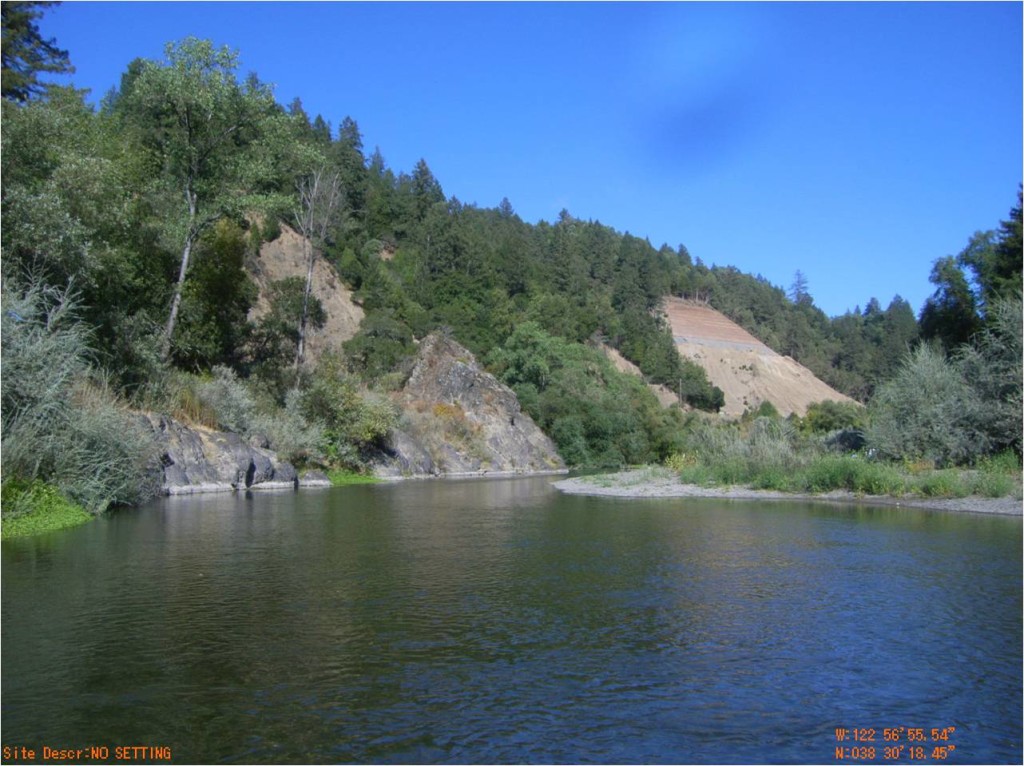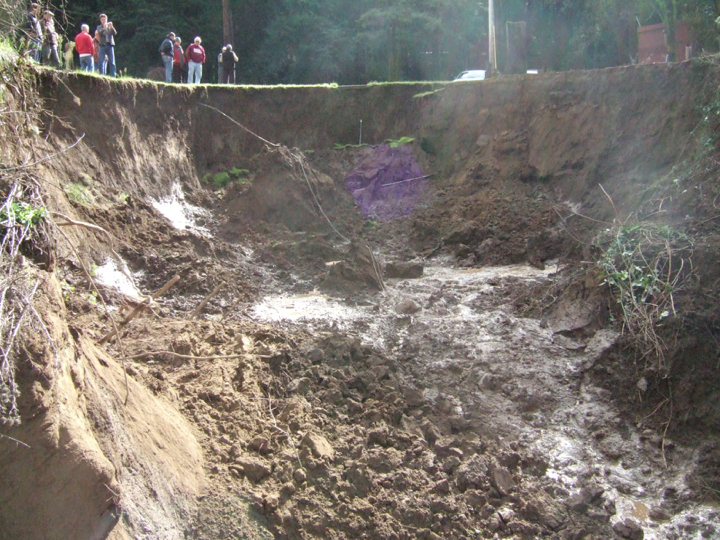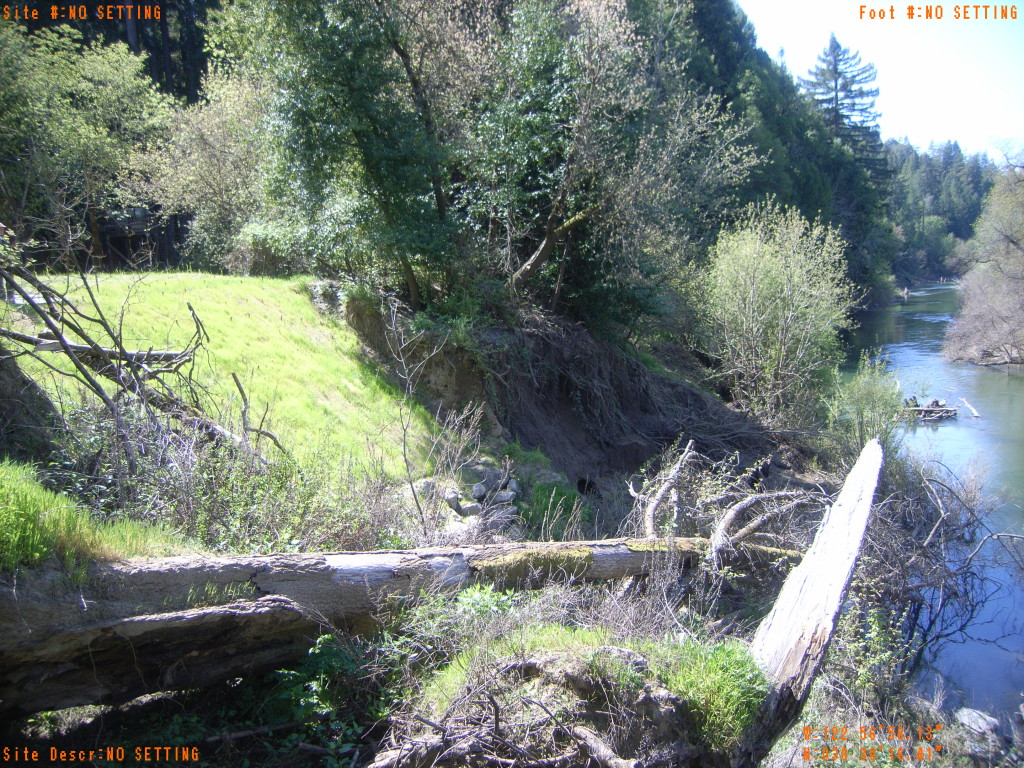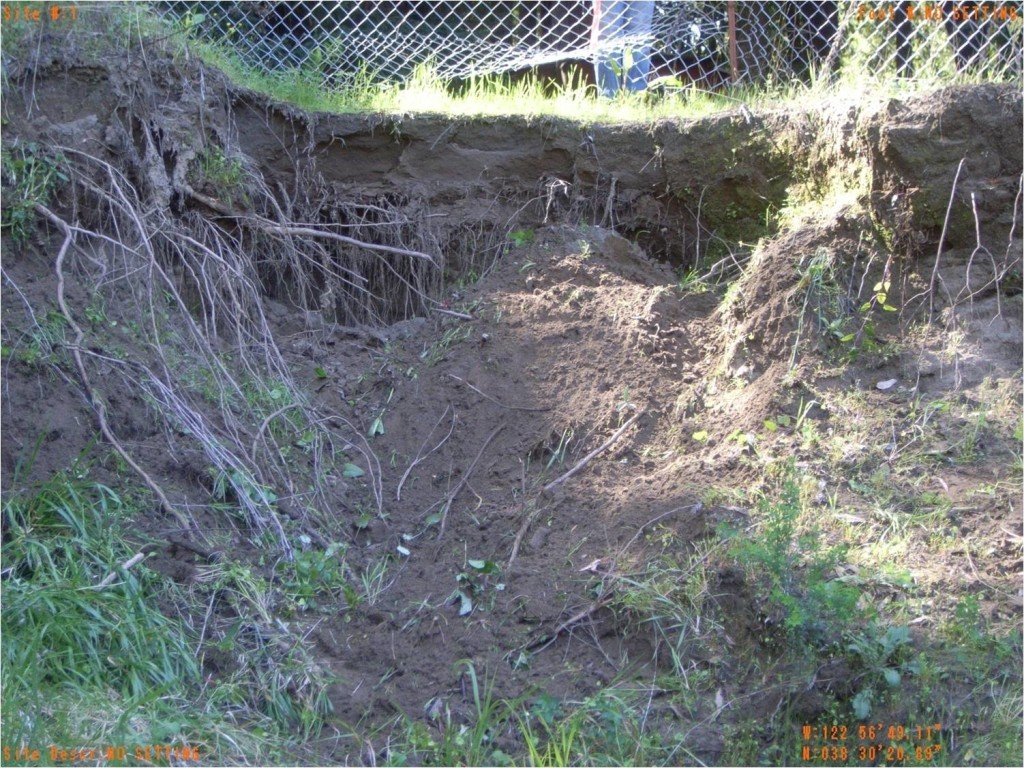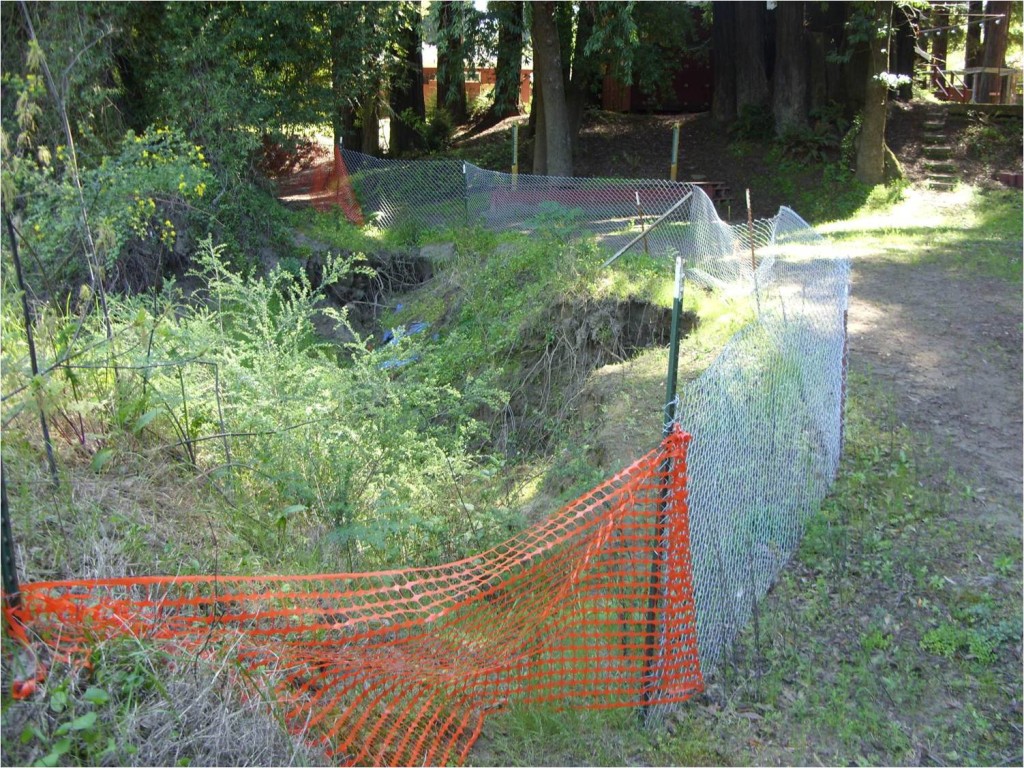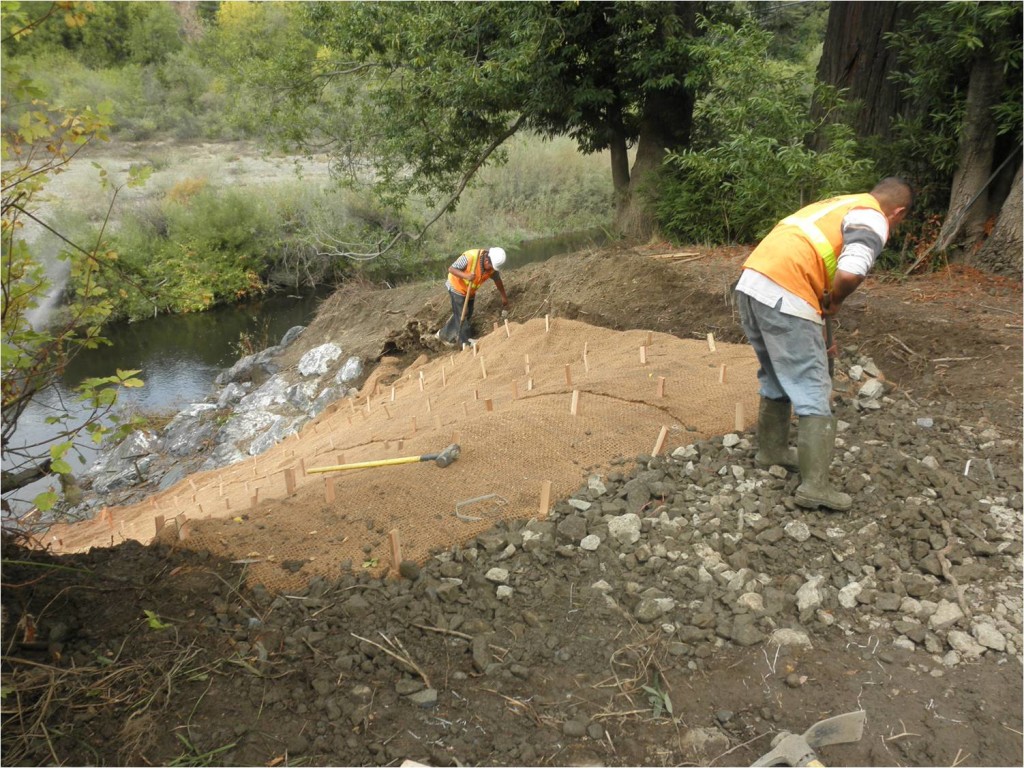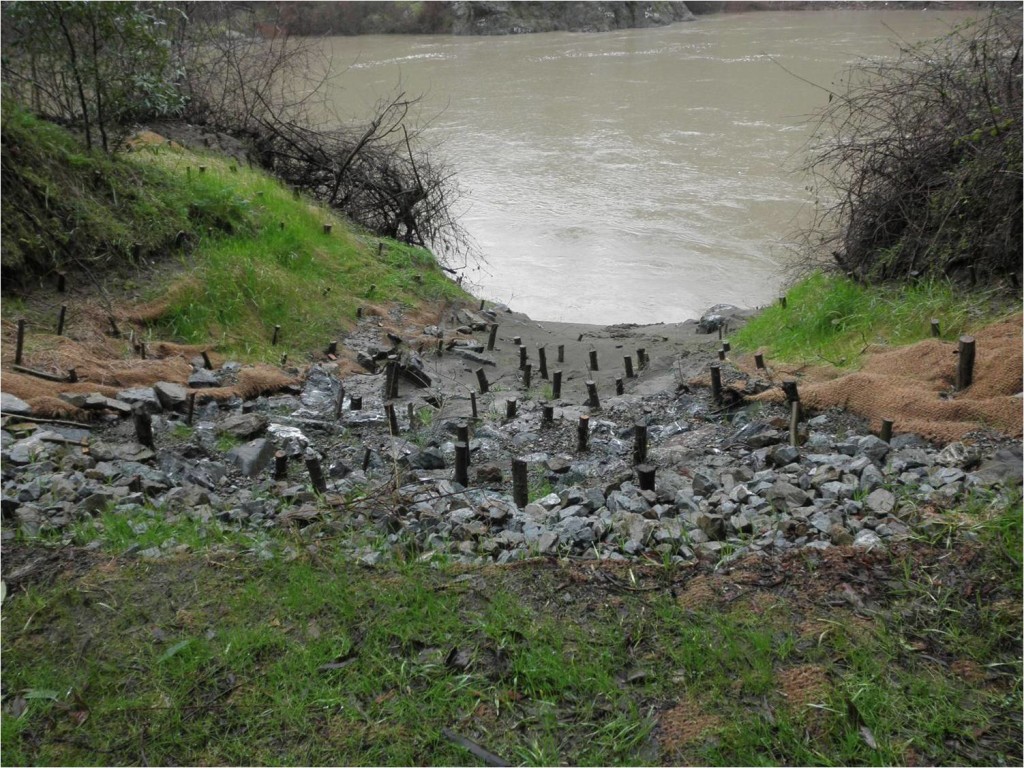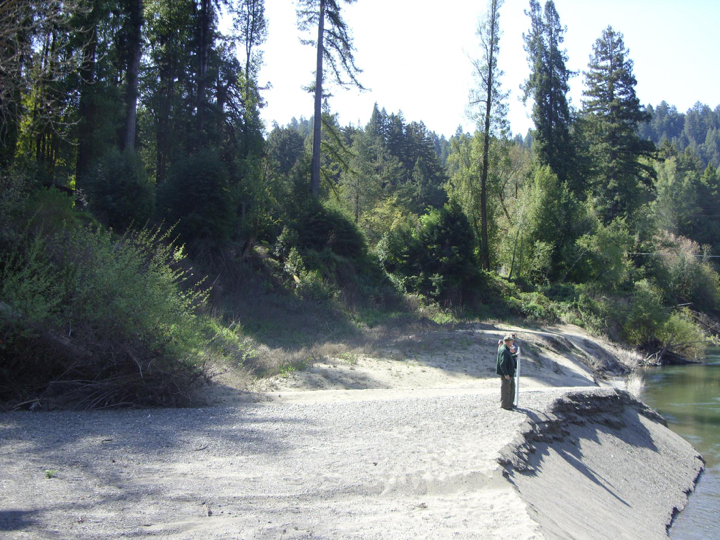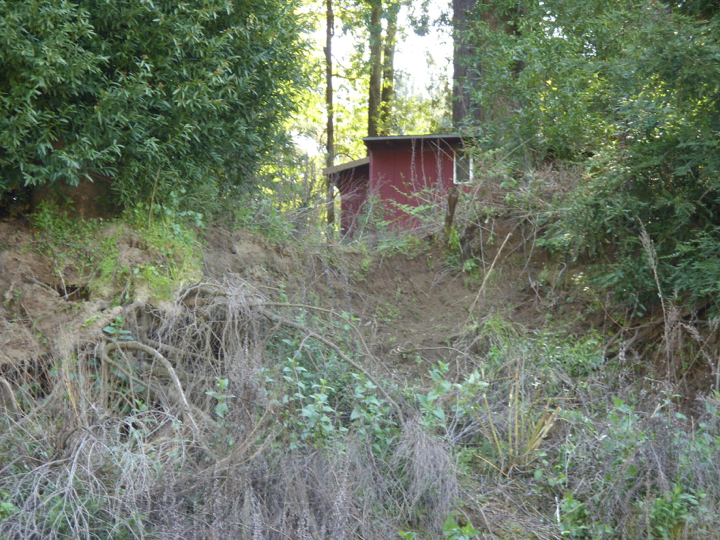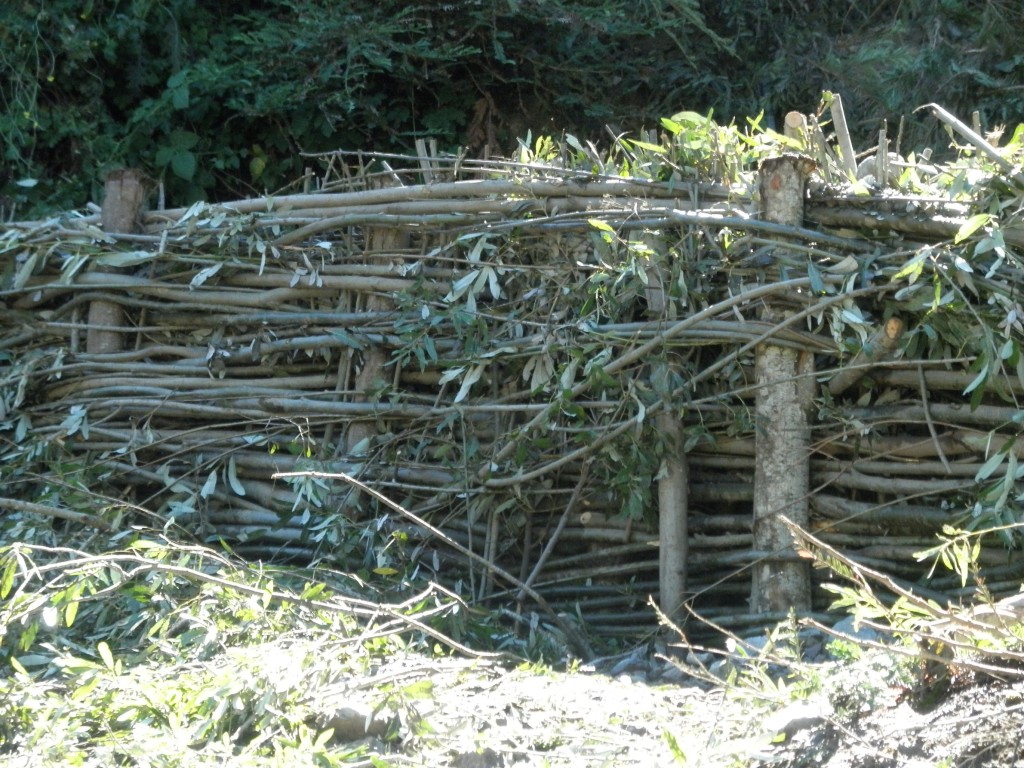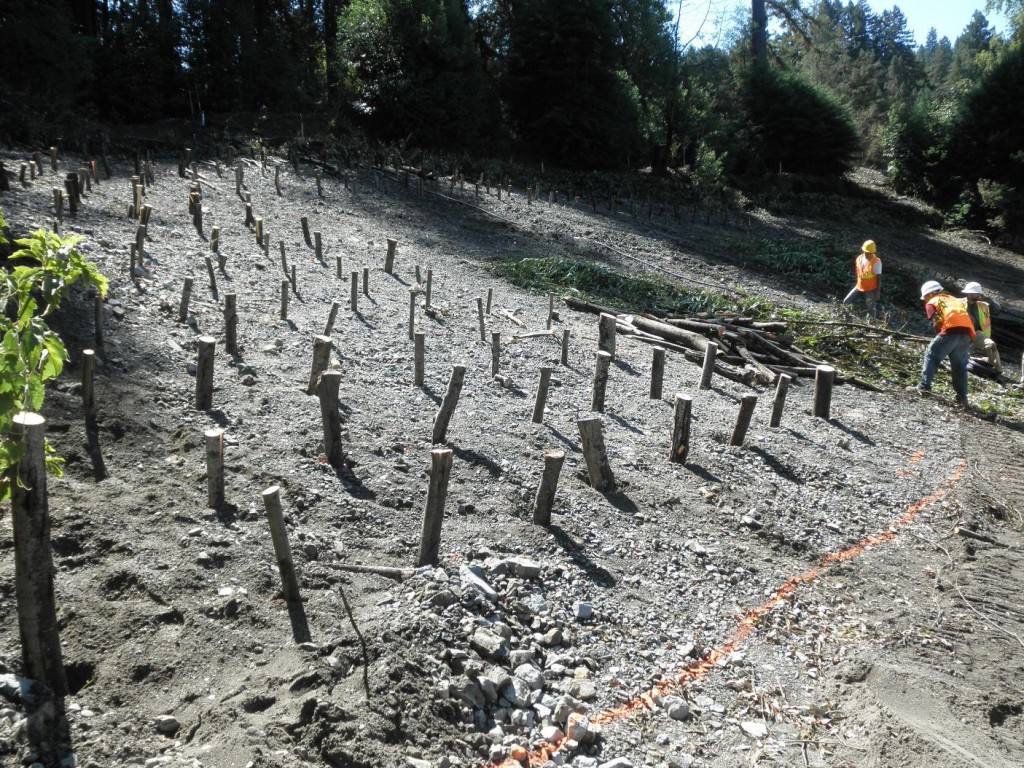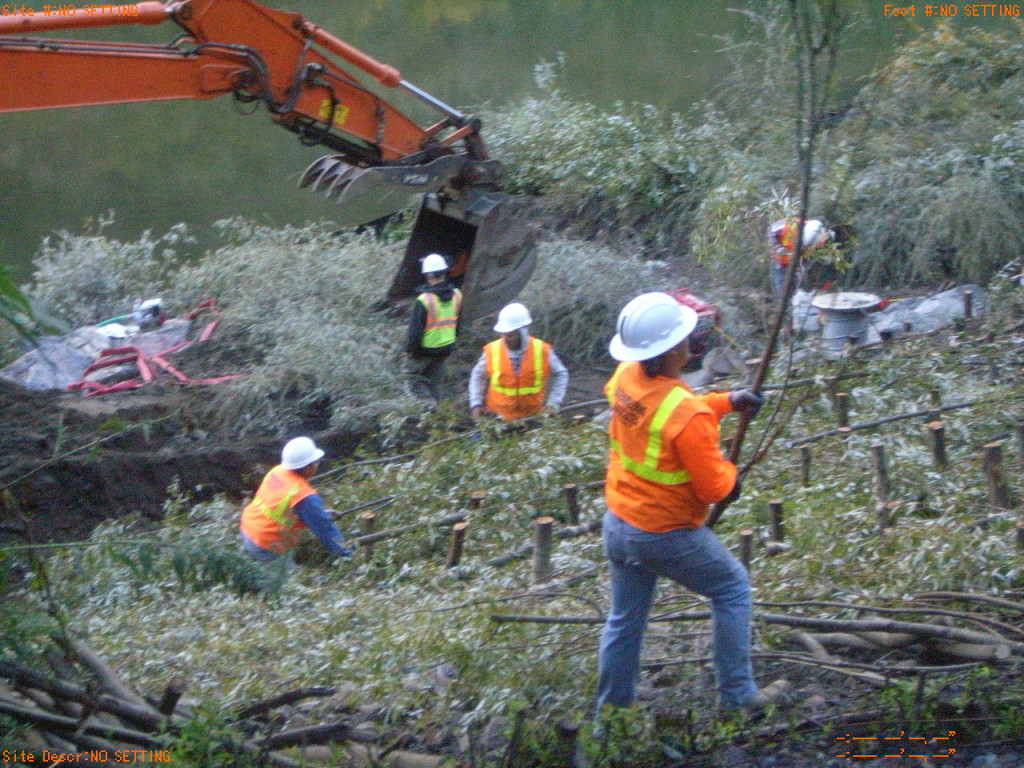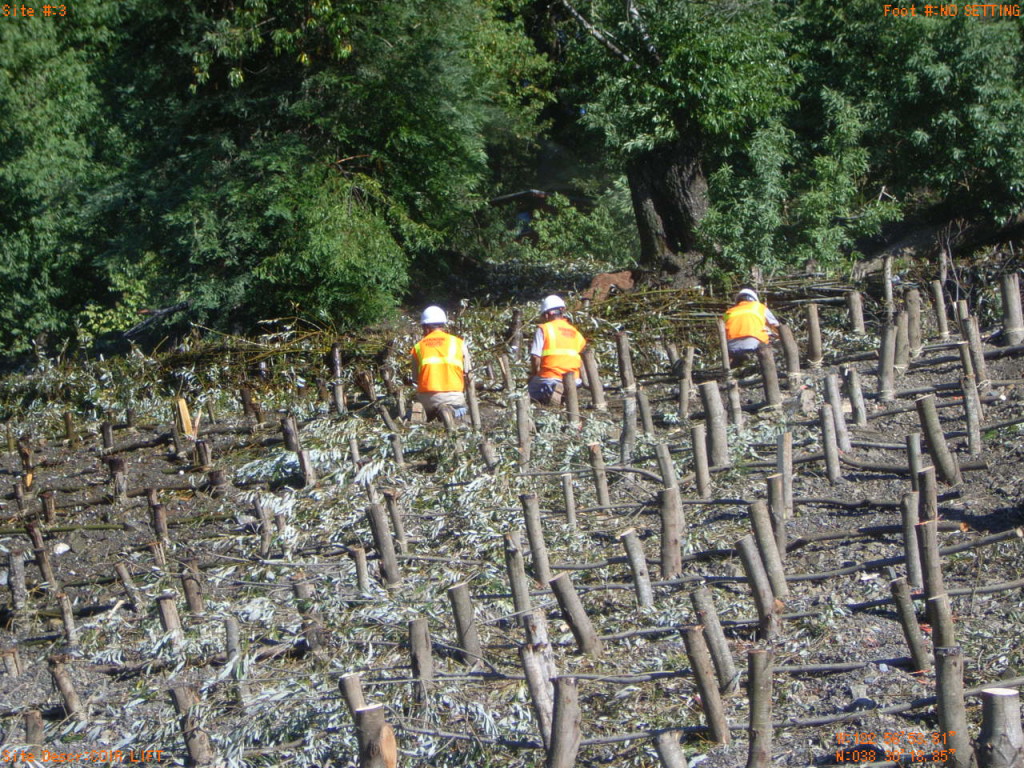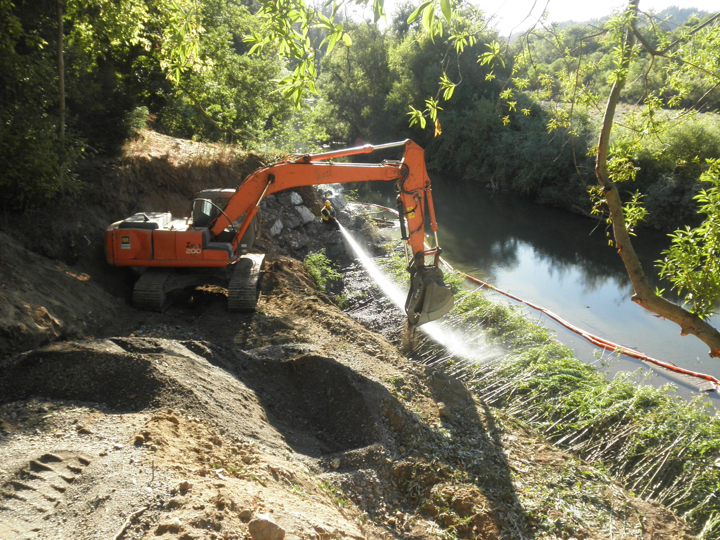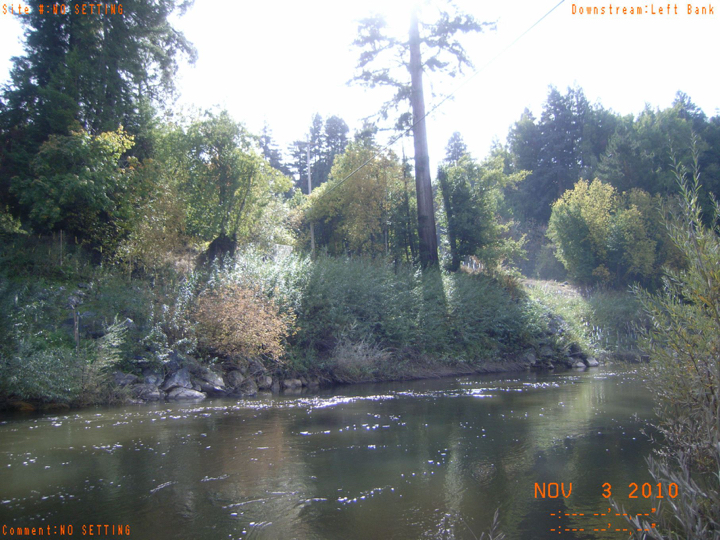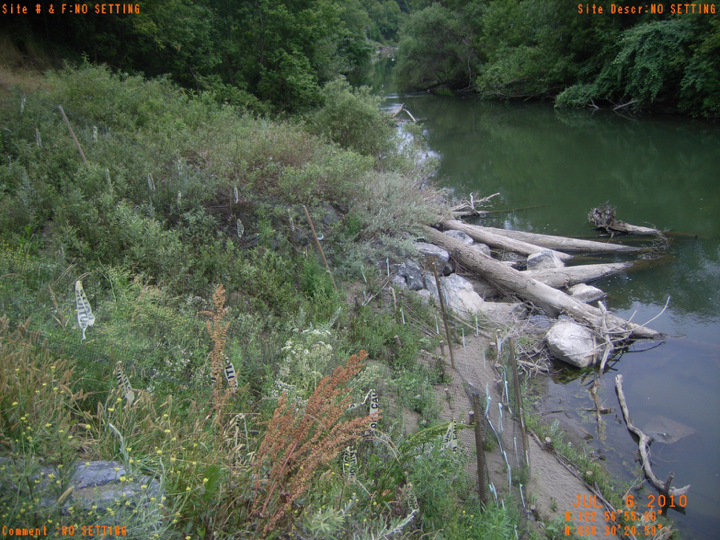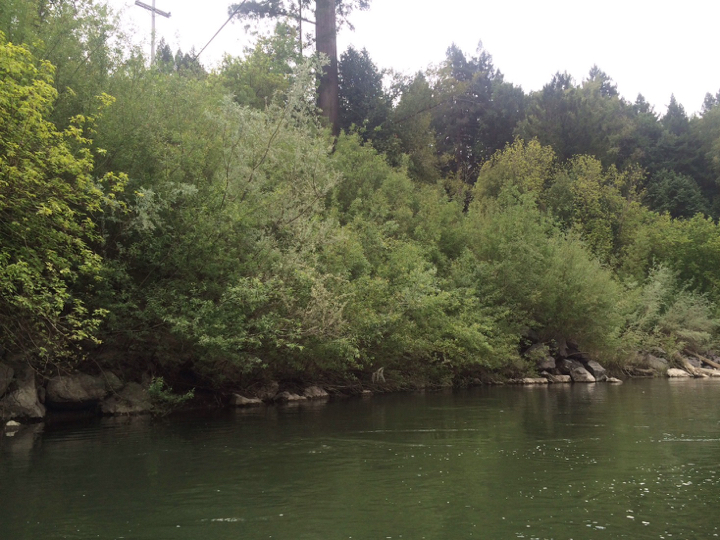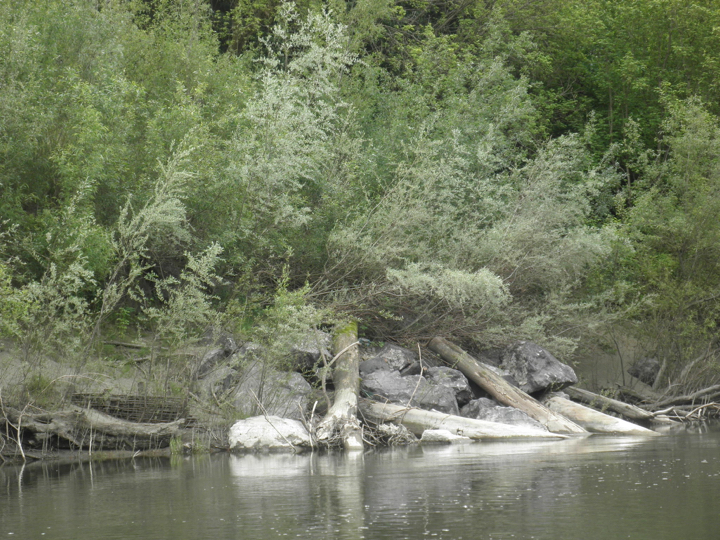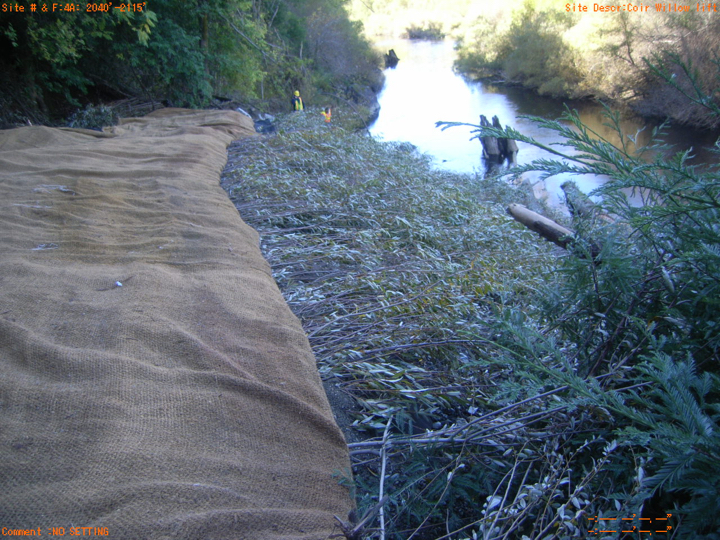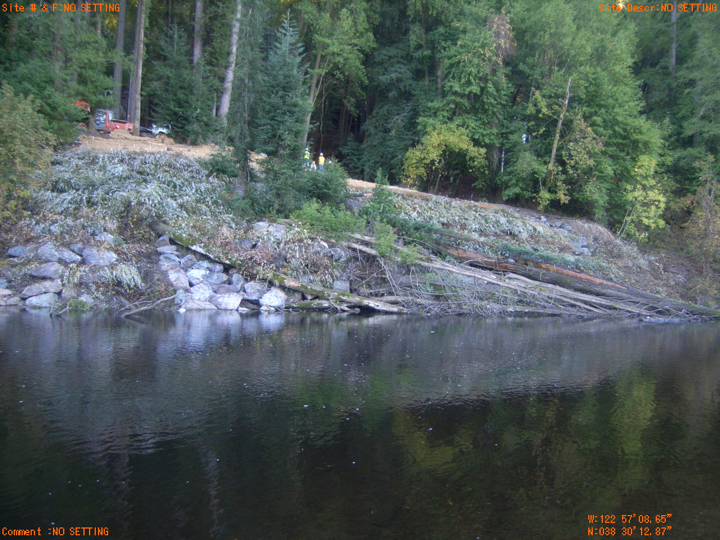Odd Fellows Recreation Club Riverbank Stabilization Project
Russian River
Guerneville, California
The Odd Fellows Recreation Club (OFRC) is a small private community, home to about four hundred residents. The club also provides a large number of cabins, camping and RV sites for member’s guests. Access to homes and other facilities is via a single narrow paved road. During the winter of 2004/05 a series of storms began to destabilize large sections of the riverbank along thousands of feet of their property, threatening homes and cabins, buried water and electrical lines, and a newly constructed multi-million dollar sewer system.
The group hired a conventional engineering firm to design a repair which consisted of pulling back the bank to a stable slope and covering that bare soil with approximately 40,000 tons of rock. The design proved to be very expensive, near impossible to acquire permits for, and quite unfeasible as 2,000 truckloads of rock would have created a severe traffic passage problem on their narrow access road.
Progress on a stabilization plan was halted at that point until the winter of 2008 when during a large storm a hole developed in the riverbank that was 40 to 60 feet wide 25 to 40 feet deep and extended 100 feet inland to the face of a 10,000 gallon septic holding tank.
One of the OFRC Board members had heard of our company and asked us to come by and have a look at the problem. That was our introduction to what was to become an award winning project that when implemented, would stabilize and revegetate over 1,200 feet of riverbank and flood terrace along 2,115 feet of the Russian River. The stabilization/revegetation work used a large number of different bioengineered live structures and only 4,000 tons of rock.
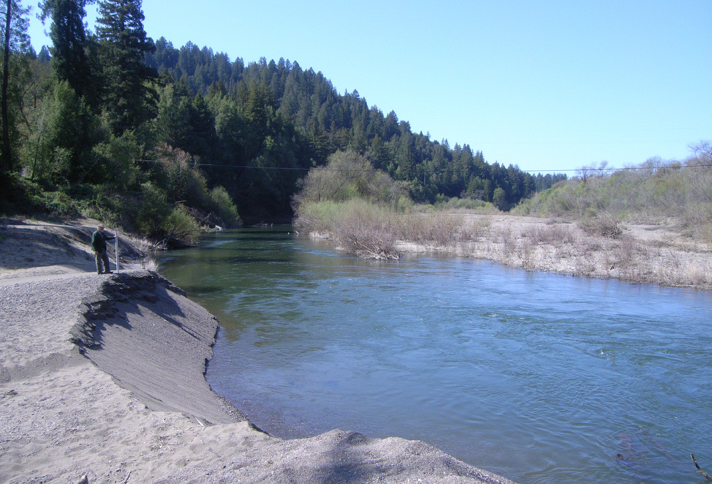
A mid channel gravel bar across the river from the OFRC property was growing larger with each storm flow and pushing the erosive force of the river against the OFRC riverbank
February 2008: Following a large storm a hole developed in the riverbank that was 40 to 60 feet wide 25 to 40 feet deep and extended 100 feet inland to the face of a 10,000 gallon septic holding tank. Over 6,000 cubic yards of soil were washed into the river. This was BioEngineering Associates’ introduction to the erosion problems facing the OFRC.
As a temporary emergency measure, the community had brought in an excavator to place boulders into the growing hole. Unfortunately the mud flow from the hole was so intense that it floated the boulders out into the river. Later these boulders were used as part of the log and boulder fish habitat structure built at the site.
BE filled in the hole using an NRCS design which consisted of installing a drain system at the base of the tank and filling the hole with one foot lifts of engineering fill compacted to 95%.
The full stabilization project was divided up into four primary sites along with constructing many roughened channels below culverts which ran underneath the access road to the community.
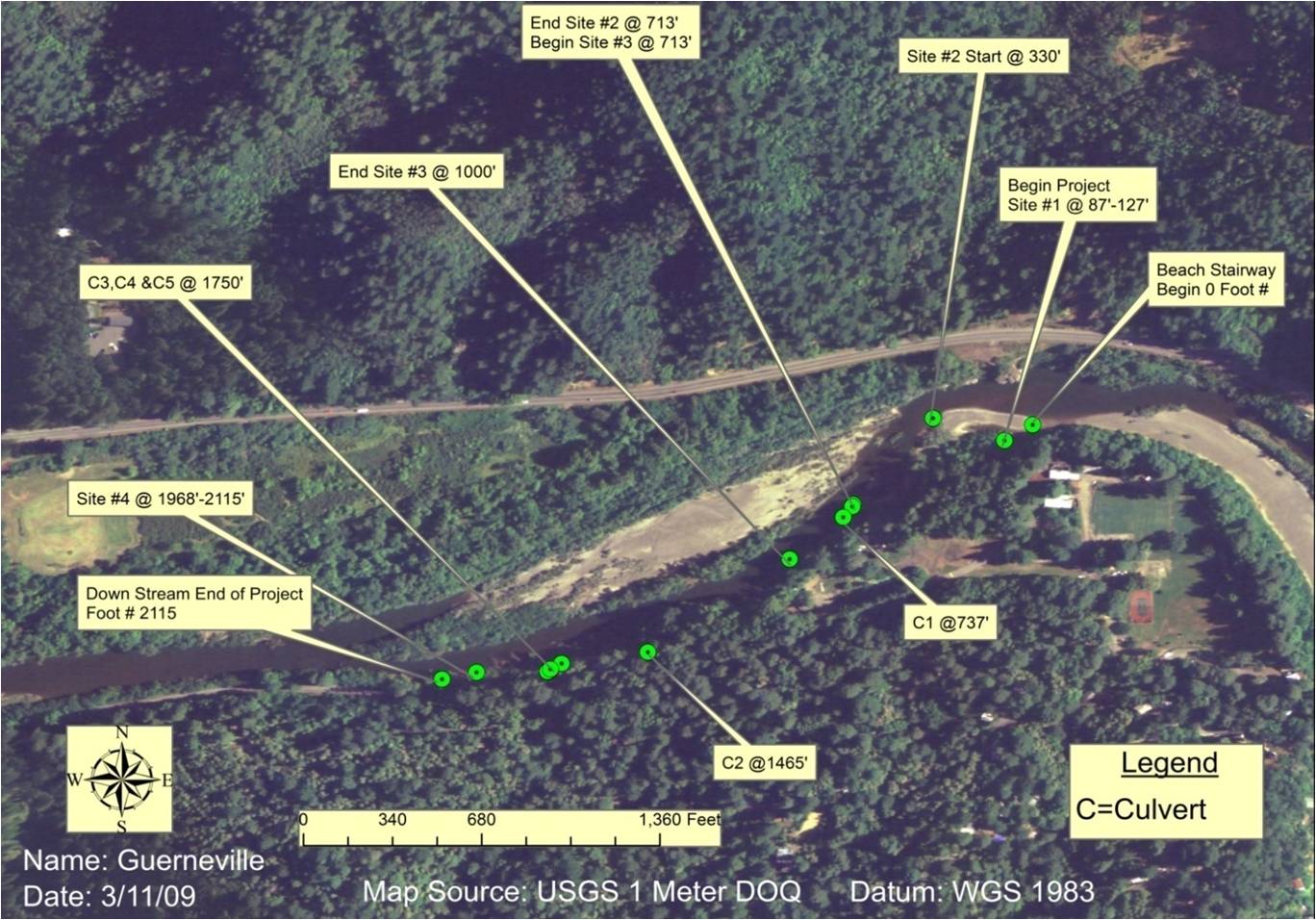
Odd Fellows Recreation Club Project Site Map
Site #1 Construction
At site #1 a gully had formed as a result of runoff which was directed through a small opening down to the river. The headcut at the top of the gully was threatening an access trail and other developed areas. To solve this problem and save the trail, BE constructed a roughened channel and staked the channel with live willow posts.
- The eroding gully was approximately 20 feet wide and 60 feet long.
- The headcut at the top of the gully was threatening the community’s developed areas.
- The headcut was filled and coir fabric was placed over the filled area. The coir fabric will prevent another headcut from forming.
- This picture was taken on the receding leg of a flood. The gully is no longer a threat to OFRC’s facilities.
Site #2 Construction
Site #2 was the largest and most complex. The erosion at site #2 was threatening a group of cabins, a cluster of redwood trees, and a wastewater holding tank. The site was 380 feet long with a 5 – 7 foot high vertical scarp at the top moving toward the cabins with each storm. To halt the erosion at this site and save the cabins, we cleared the scrub vegetation and reshaped the bank to three different gradients, one for the willow wall which stabilized the eroding vertical scarp, one for the live willow mattress that stabilized and revegetated the largest portion of the site and one for the live willow baffles at the toe of the site, installed to protect the other bioengineered structures built above it and to collect sediment and re-establish a willow grove by the water’s edge.

The site was graded for the installation of live willow siltation baffles, live willow brush mattress, and live woven willow wall. A flat was carved at the top of the site for the willow wall, below it a 5 to 1 slope was shaped for the willow mattress and then, an 8 to 1 gradient shaped for the baffles.

Before we got to the very top of the eroding bank we built a flat terrace where a live woven willow wall was installed. This allowed us to have a shallower, slope in the sections closer to the river. This structure functions successfully as a live retaining wall. In this photograph, an excavator uses a hydraulic hammer to drive in the live willow post.

Fill was poured between the willow wall and the top of the bank prior to installation of an erosion control blanket, mulch and seed.
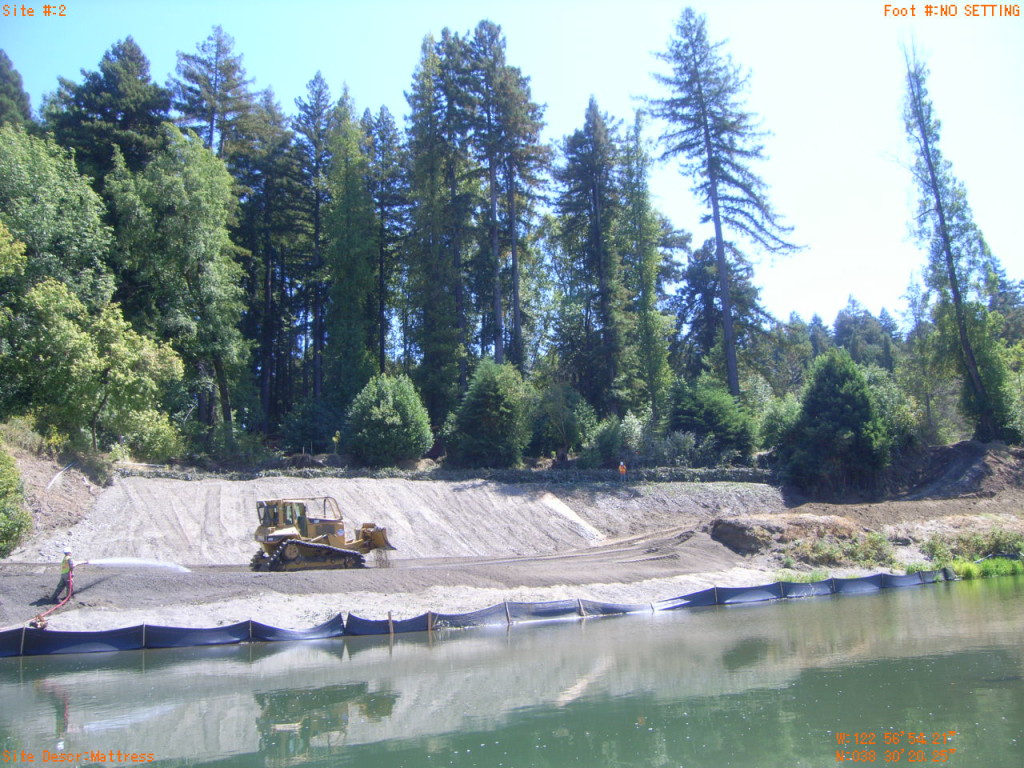
The site has been graded and ready for construction of the live willow brush mattress. The live woven willow wall is at the top of the slope.
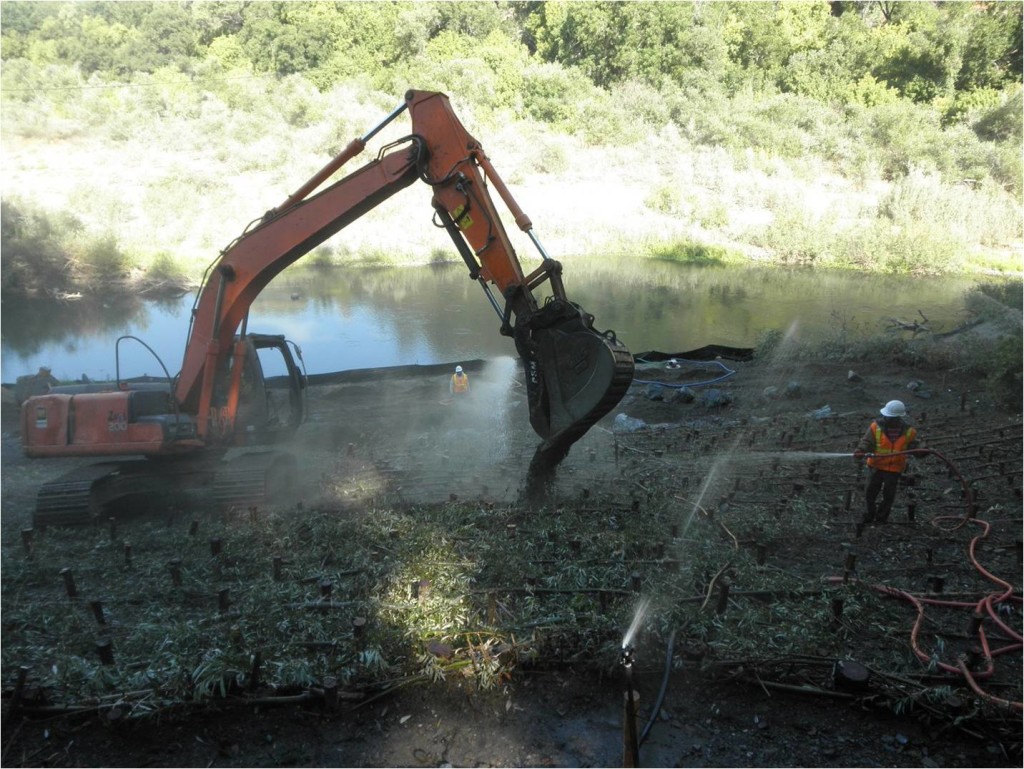
The willow is covered with a thin layer of river run gravel, which is washed in with a high pressure hose.
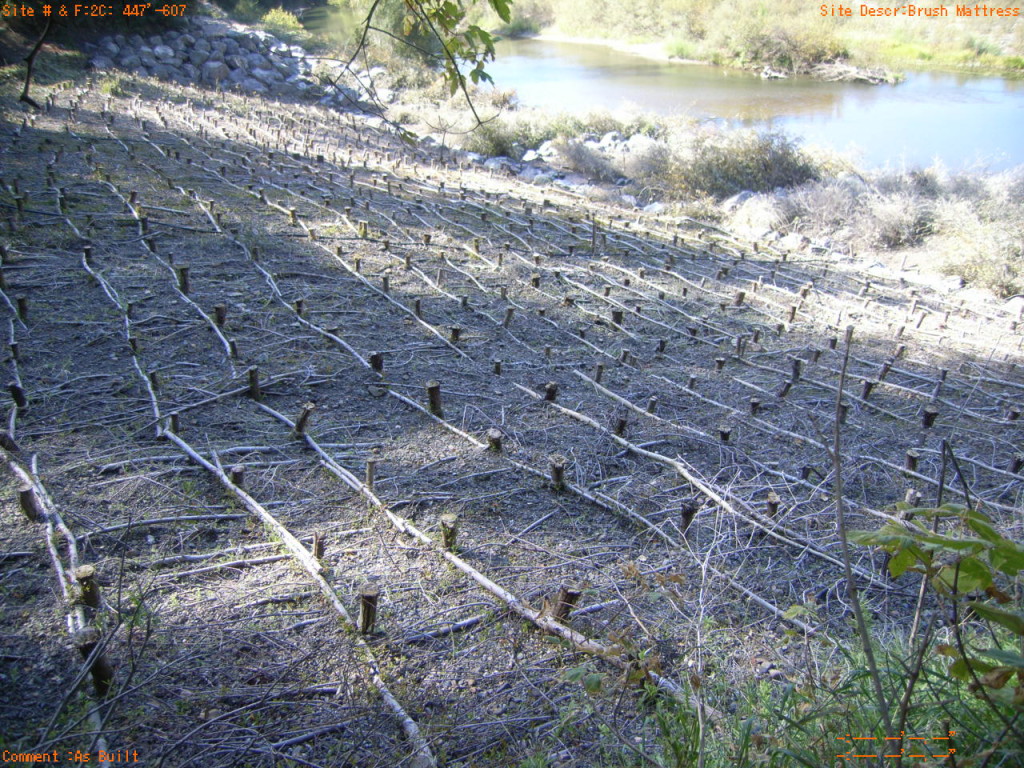
With the live willow brush mattress completed and covered with river gravel we begin to build the live willow siltation baffles that will extend from the bottom of the mattress to the river.
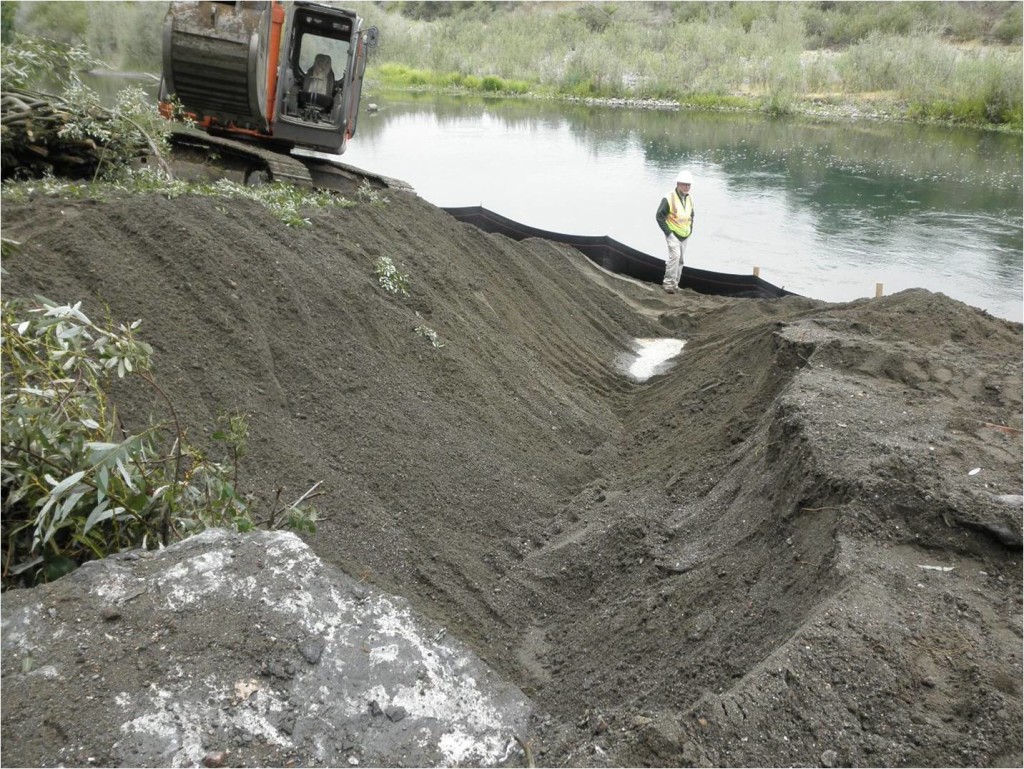
A seventy-five foot long trench was excavated in preparation for installing the first of a series of live willow siltation baffles. The baffles will extend from the water’s edge up to the willow mattress.
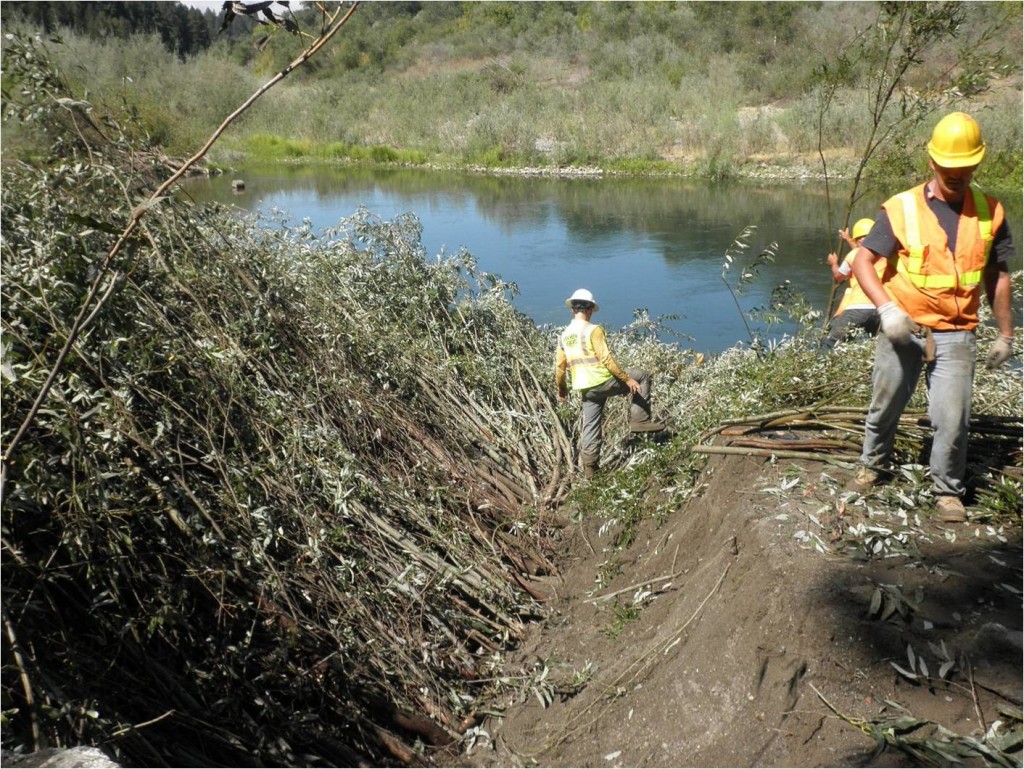
Construction of the live willow siltation baffles. Crews placed live willow branches into a baffle trench.
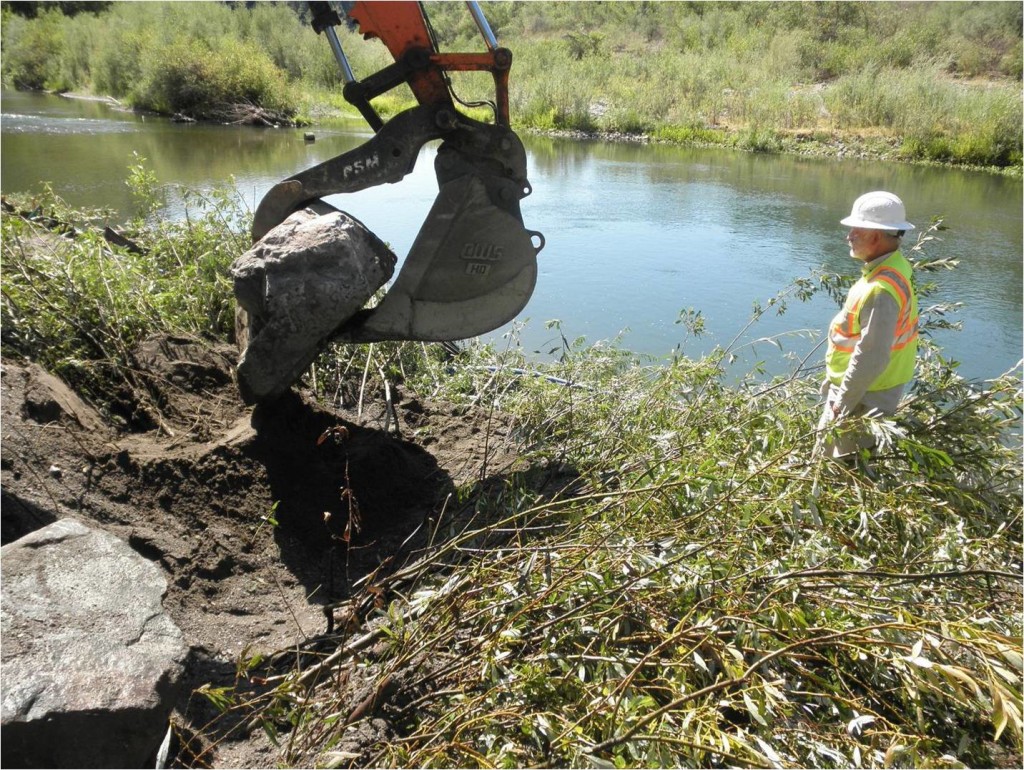
The excavator places the two to three ton boulders in the baffle trench which has been partially filled with the excavated soil. The boulders will hold the live willow branches in place.

Newly completed live willow siltation baffle. The boulders will disappear, buried in trapped sediment after the first flood.

Site 2 is complete. At the site of the equipment entry road the rock has been used to construct a large boulder deflector (on right). A series of baffles holds the toe in place. Above the baffles lies the willow mattress, and near the top, the woven willow wall
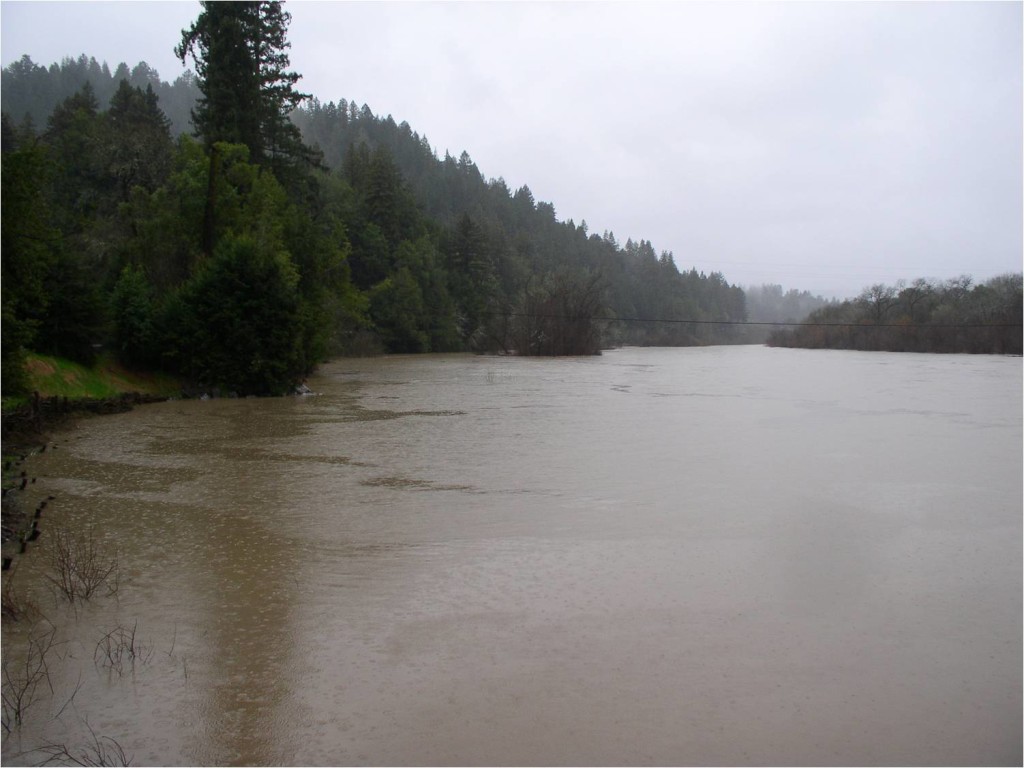
January 22nd 2010; Two months after construction was completed almost all the work is beneath the flood waters.
Site #3 Construction
Site #3 included the February, 2008 emergency project along with other erosion problems which threatened the long term stability of the area. In the middle of the site, just upstream of the emergency project, was a promontory formed by a grove of redwood trees. The riverbank on either side of the promontory was slipping into the river.
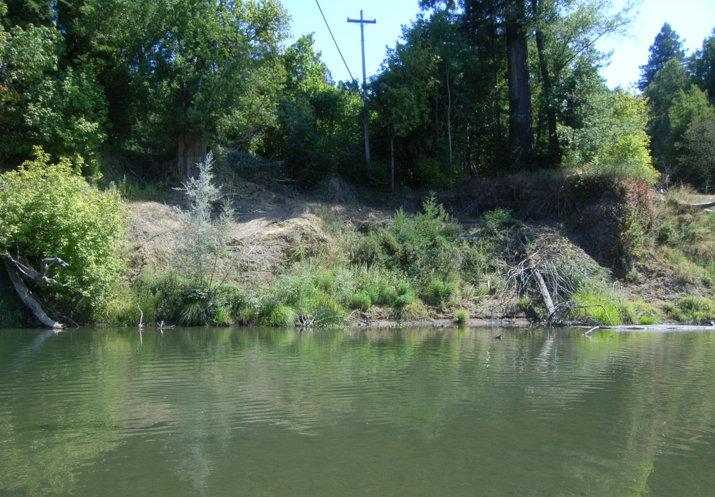
Redwood tree promontory on the right of the photograph. Pictured above is the upstream portion of site #3.

The riverbank was slipping into the river along a 90 foot stretch of bank upstream of the promontory.
Upstream of the promontory, 90 feet of riverbank was slipping into the river, leaving behind a 10 – 12 foot tall vertical bank, retreating toward the Club’s facilities. In this area a series of rock and live willow brushlayer lifts were constructed. Further up the bank on top of the rock and live willow brushlayer lifts, the design changed to coir wrapped soil and live willow brushlayer lifts. The redwood tree promontory in the middle of the site was stabilized with a large boulder wing deflector with live willow stakes driven into the gaps between the boulders. Downstream of the promontory, a live willow brush mattress was constructed with a live woven wall toe. Just downstream of the mattress, the remainder of the site was stabilized with a series of rock and live willow brushlayer lifts and coir wrapped soil and live willow brush layer lifts. A log and boulder fish habitat structure was constructed from the toe of the lifts down into the river.

The downstream portion of site #3 prior to bioengineering construction. The boulders in the water are the ones that washed into the river when the mud was flowing from the riverbank blow out. This is the location of the 2008 emergency project.
With the site excavated and a stabilizing toe of large boulders in place, the crew begins building the rock and live willow brushlayer lifts, a multi-layered sandwich of quarried boulders, river gravel and live willow branches.
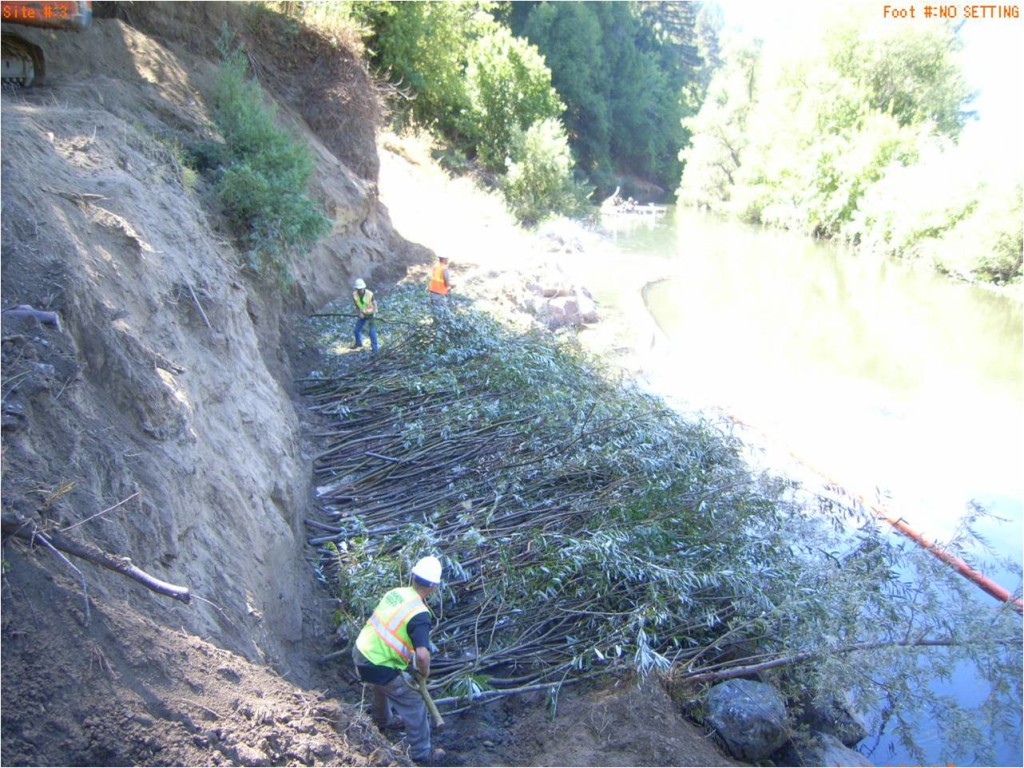
Crew members place a dense layer of live willow branches forming the brushlayer of the rock and live willow brushlayer lifts.
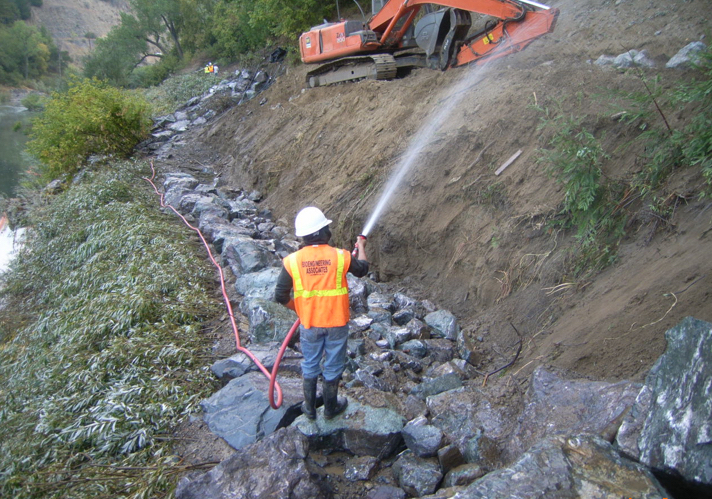
Following the layer of live willow branches and river gravel, boulders are placed on top of these layers forming a new rock platform for the next brushlayer to be constructed on. In this picture, a crew member uses a high pressure hose to wash in the river gravel in between the boulders.
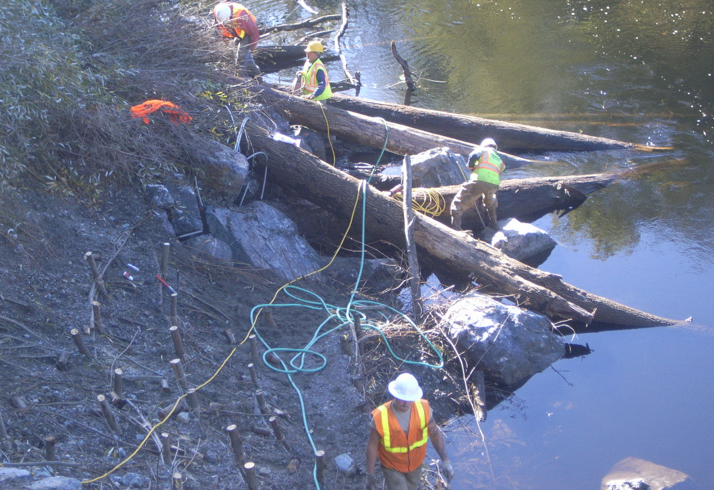
Just downstream of the promontory, a live willow brush mattress with a live woven willow wall toe was constructed. A boulder and log fish habitat structure was constructed below the rock and willow lifts. The crew fastened the boulders and logs together with threaded rebar, steel cable and epoxy.
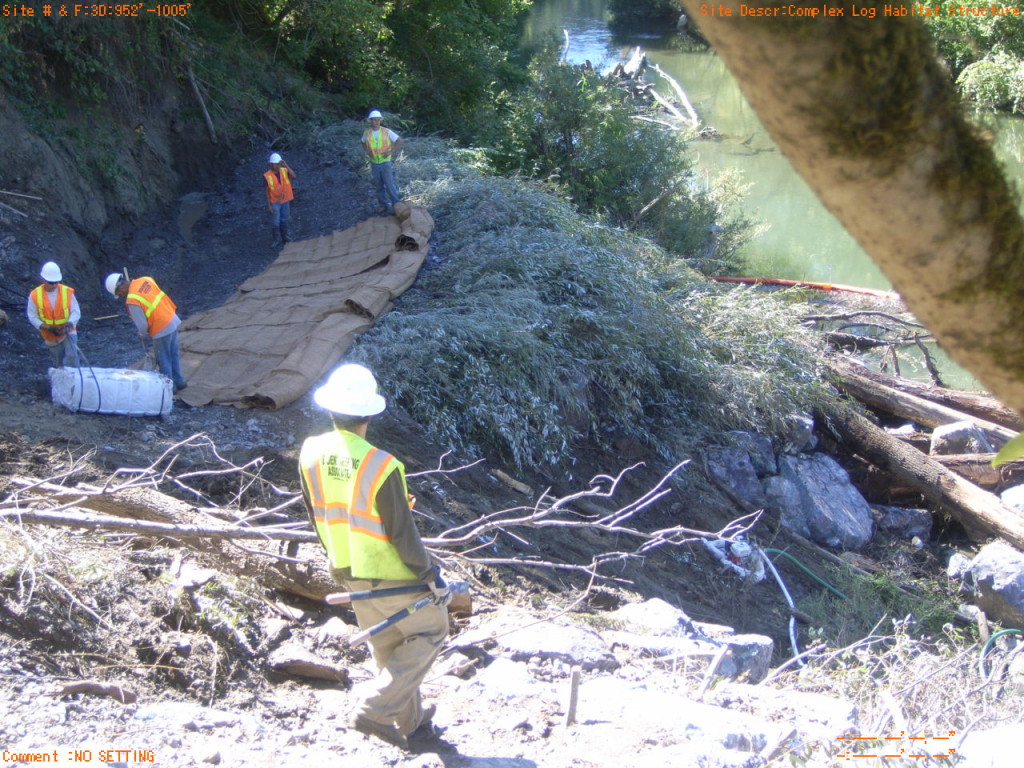
Just above the fish habit structure, a series of 2 rock and live willow brushlayer lifts were constructed followed by coir wrapped soil and willow lifts.
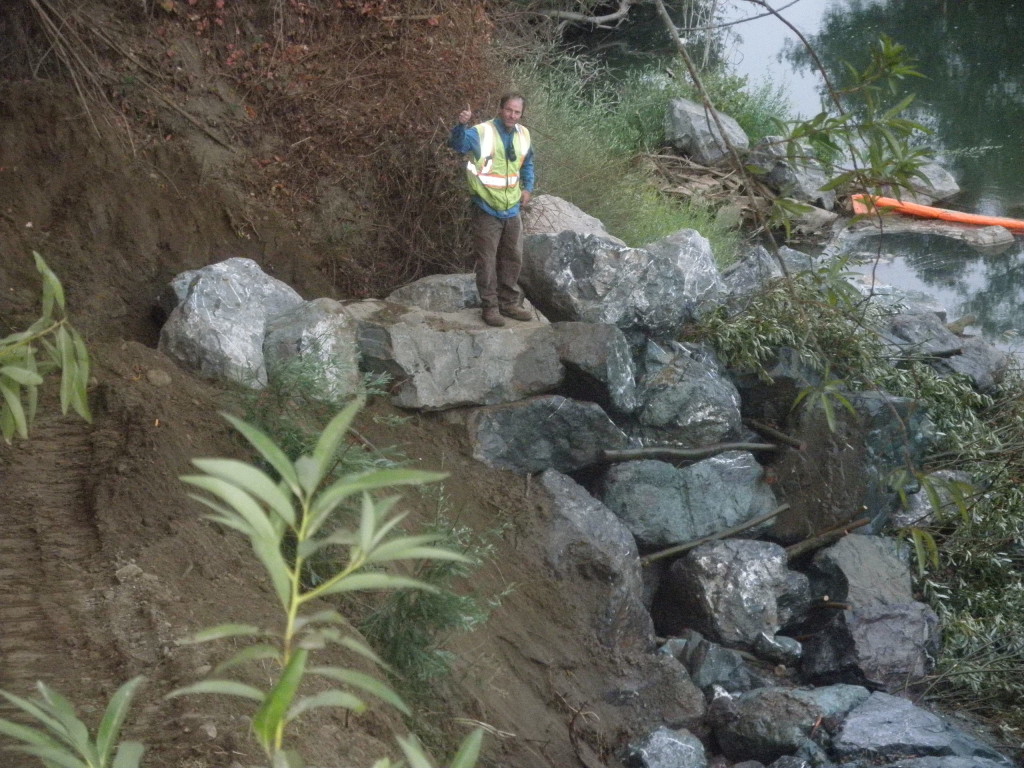
BE’s lead heavy equipment operator, Cameron Hill, standing on one of the 4 ton boulders he placed to construct the boulder deflector around the redwood tree promontory.
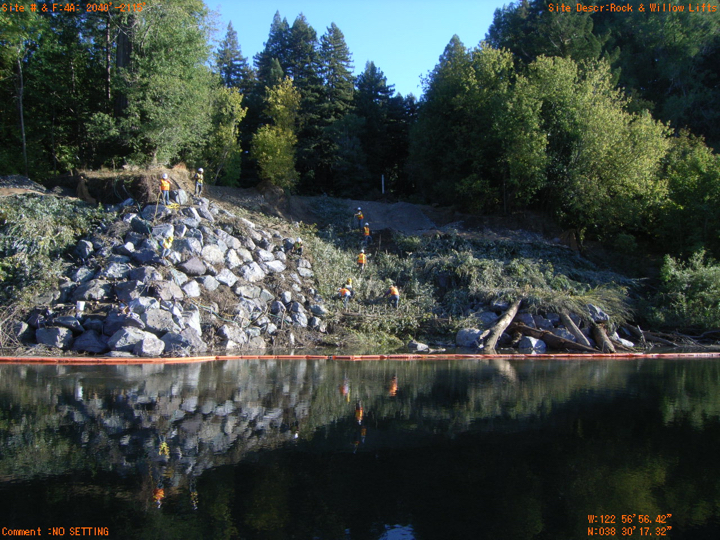
Construction at site #3 is almost compete , with the boulder wing deflector on the left, live willow brush mattress with woven willow wall toe in the center, and on the right the fish habitat structure, just below the rock and willow lifts.
Site #4 Construction
At site #4, several large redwood trees and other canopy trees had fallen into the river leaving a 150 foot section of bare vertical bank. The riverbank erosion at this site threatened nearby homes and the main access road to the Odd Fellows community. The fallen trees provided excellent habitat for fish and the regulatory agencies wanted this habitat to remain. In order to accomplish this the fallen trees were moved and used in the construction of a log and boulder fish habitat structure. Just above the habitat structure, we built a series of rock and live willow brushlayer lifts which were followed by coir and willow lifts.

At the very top of the site, a vertical 15-foot by 90-foot actively eroding bank threatened the nearby road and houses.
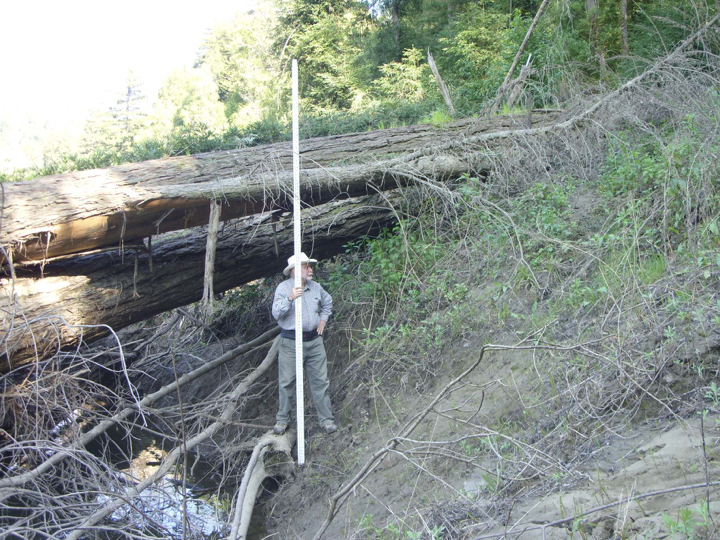
At the bottom of this site, the challenge was to construct the bioengineering structures while keeping the fallen Redwoods in place in the water as fish habitat.

After the logs were cut and moved, the crew use threaded rebar and galvanized steel cable to fasten the logs together for the fish habitat structure.
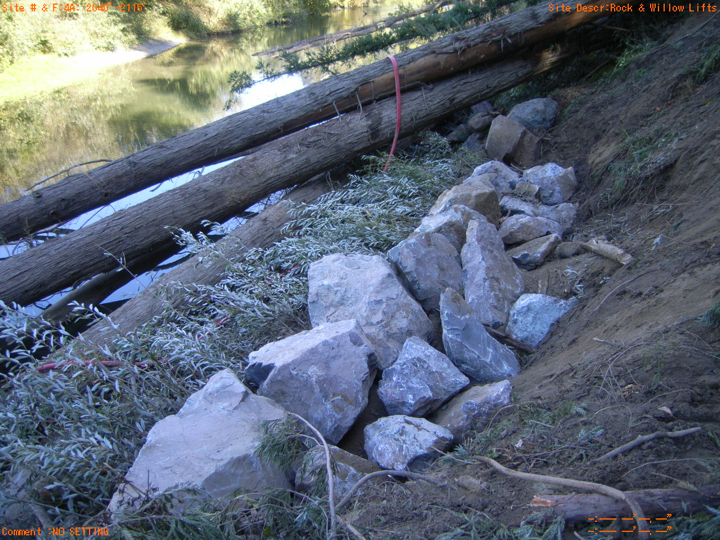
Large boulders were placed deep in the water at the toe of the eroding bank. Layers of boulders and willow were then used to reconstruct the lower section of bank.
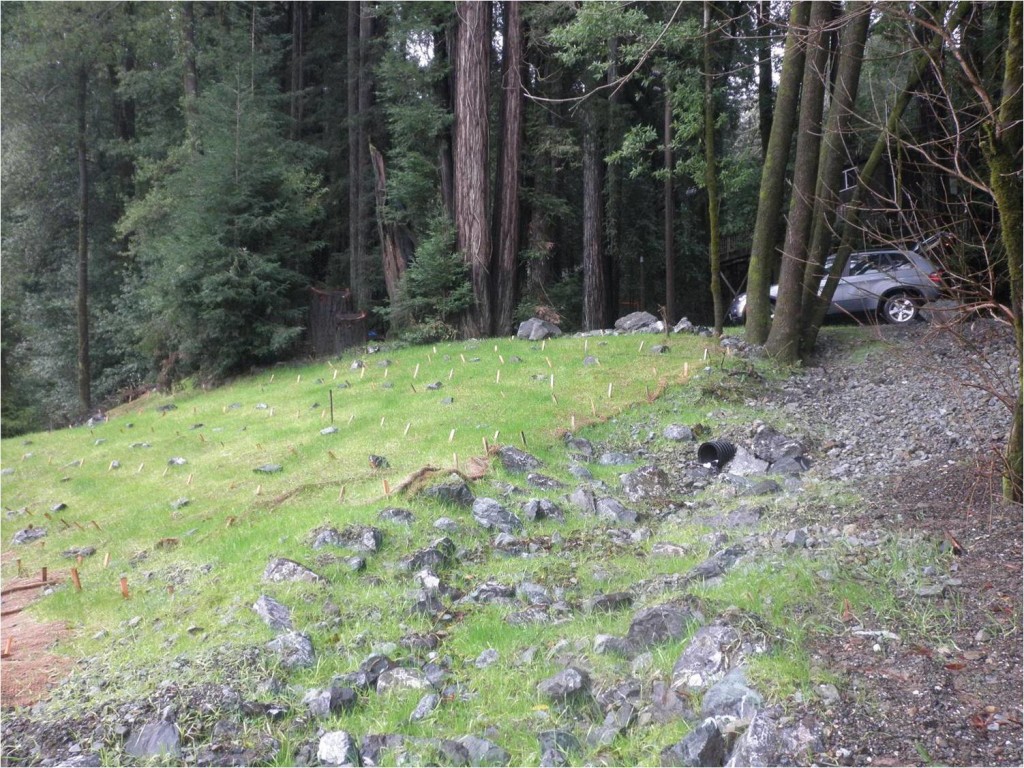
The rest of the area between the lifts and the top of the bank was filled with a mix of small rock and river gravel. The fill was covered with a layer of coir blanket and coir netting and then seeded with a native grass mix. An armored channel was built to carry culvert flows safely down to the river.

